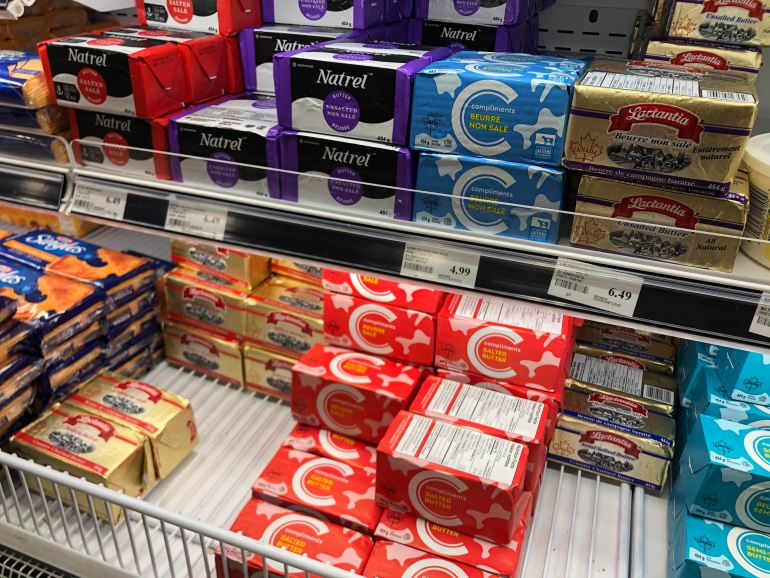US stimulus saga, ‘Buttergate’ and Minnesota’s wilderness battle
It’s been a busy week of business headlines and economic news, but if you’ve been too busy looking out the window and wishing for sunnier days ahead to pay attention to any of it, trust us — we get it.
TL;DR: the ongoing United States stimulus saga seems like it’s finally ready for a critical vote, jobs are coming back (slowly) and something super weird is happening to butter in Canada.
If that sounds stressful, don’t worry: we’ve got a Minnesota wilderness moment of Zen coming your way, too. So pour yourself another cup of coffee and scroll through the biggest business news stories you might have missed this week on that long commute from your bedroom to your living room.
379,000
The number of jobs the US added in February, a sign the labour market is picking up steam again after a brutal close to 2020.
“February’s gains were even more impressive given the harsh winter weather that tore through the southern states last month, and most of the jobs that were added in February were in leisure and hospitality – the hardest-hit sector of the economy,” writes Al Jazeera’s Managing Business Editor Patricia Sabga.
The February jobs report offers a year-over-year comparison with February 2020 – the pre-pandemic benchmark for many labour market statistics.
Those comparisons show just how far the nation’s jobs market is from recapturing its pre-pandemic strength. Take the unemployment rate. Last month it ticked down slightly to 6.2 percent – encouraging, but still nearly double the pre-pandemic rate of 3.5 percent from a year earlier.
$1,400
US President Joe Biden’s $1.9 trillion COVID-19 relief package is finally nearing the end of a long, legislative slog. But getting it across the finish line has required Biden to budge on a crucial part of the proposal — $1,400 stimulus cheques written out to struggling Americans.
Republicans had argued that Biden and Congressional Democrats’ original parameters would have given out too much cash to people who didn’t really need it. So Biden and Democrats signalled they were willing to shut their pocketbooks a little bit — lowering the cut-off for individuals from those earning more than $100,000 per year down to those earning more than $80,000, and $160,000 for couples.
That means fewer people will be eligible for direct payments at a time when the labour market recovery is lagging other parts of the economy. But it also means the bill will have a better chance of passing — and in a Senate split evenly between Republicans and Democrats with Vice President Kamala Harris casting the deciding vote, that’s crucial. Americans have also been waiting for this aid for a long time — many of the first COVID relief bill’s protections ended last summer.
More than 150
The number of US medical technicians who walked off the job on Thursday at a Bend, Oregon hospital in what could become one of many labour strikes by hospital workers stretched to the breaking point by the coronavirus pandemic.
Medical technicians such as respiratory therapists and ultrasound techs are a smaller workforce in many US hospitals compared to nurses and doctors, and they often have fewer labour protections and are less likely to be unionised. During the COVID-19 crisis, they’ve provided essential care but generally have been less visible — until now, writes Al Jazeera’s Lizzie Mulvey.
The strike by workers from St Charles Medical Center in Bend underscores a larger issue about the protections all front-line workers need and demand, labour experts say.
“The fact that some technologists are playing an absolutely crucial role in keeping COVID patients alive, especially respiratory therapists, while facing incredibly difficult work that is both physically and emotionally gruelling, I think that that creates an atmosphere where workers are ready to demand more,” Rebecca Givan, an associate professor of labour studies at Rutgers University, told Al Jazeera.
80 percent
The minimum share of milk fat that butter is required to have, according to Canada’s regulators. But something funny has been happening with Canadian butter recently: it isn’t softening at room temperature anymore.
 Canadians want to know what’s behind the mystery of a phenomenon they have dubbed ‘Buttergate’ [Jillian Kestler-D’Amours/Al Jazeera]
Canadians want to know what’s behind the mystery of a phenomenon they have dubbed ‘Buttergate’ [Jillian Kestler-D’Amours/Al Jazeera]Amateur bakers trying their hand at quarantine cooking and professional chefs alike have noticed the phenomenon, dubbing it “Buttergate.”
“Several hypotheses have been put forward to explain the change in Canadian butter’s consistency, from whether the butter was overworked and thus got harder, to whether cold winter temperatures have anything to do with it,” writes Al Jazeera’s Jillian Kestler-D’Amours. “But one potential reason has received the most attention: the use of palmitic acid, a substance derived from palm oil that increases the level of saturated fat in dairy products, in feed given to Canadian dairy cows.”
That’s led to its own uproar from people who don’t want to see a byproduct of palm oil used in what is supposed to be a dairy product. Read the full story behind Buttergate here.
First
If confirmed by the US Senate, Representative Deb Haaland would become the first Native American in US history to hold a cabinet position. Biden picked Haaland, a Democrat from New Mexico, to lead the US Department of the Interior, which oversees some 640 million acres (260 million hectares) of federally owned lands. Some of that land is rich with minerals, oil and natural gas that private companies would like the chance to extract.
But they might face an uphill battle with Haaland, who “has been an outspoken opponent of fracking” and “was also a cosponsor of the original Green New Deal resolution,” Al Jazeera’s Ben Piven writes.
After the departure of the industry-friendly administration of former US President Donald Trump, many energy companies are wondering what a more environmentally friendly Biden administration will mean. That debate has already played out in Haaland’s confirmation hearings, with Washington state’s Senator Maria Cantwell, a Democrat, telling Haaland that her nomination “is a proxy fight over the future of fossil fuels”.
 The fight over the future of this part of northern Minnesota has been infused with fresh interest and speculation as the environmentally friendly administration of President Joe Biden takes the reigns from Biden’s industry-friendly predecessor, Donald Trump [Courtesy: Bryan Hansel/ Friends of the Boundary Waters Wilderness]
The fight over the future of this part of northern Minnesota has been infused with fresh interest and speculation as the environmentally friendly administration of President Joe Biden takes the reigns from Biden’s industry-friendly predecessor, Donald Trump [Courtesy: Bryan Hansel/ Friends of the Boundary Waters Wilderness]1 million
The number of acres comprised by the Boundary Waters Canoe Area Wilderness, a pristine swath of nature on the border of Minnesota and Canada that boasts thousands of lakes, dramatic rock formations, tiny islands and lush forests, writes Al Jazeera’s Cinnamon Janzer.
This stretch of wilderness is also home to a treasure trove of untapped, highly valuable minerals like copper, nickel and platinum group metals. That’s why it has become part of a fight between mining companies offering “family-sustaining” jobs and conservationists and outdoor tourism companies that rely on the area’s unspoiled beauty to make their living.
We know, that sounds stressful, and we promised you a Minnesota moment of Zen. So before you head over to read the full story, picture yourself in this canoe. Breathe in, breathe out. And start your weekend.
Source: Thanks AlJazeera.com